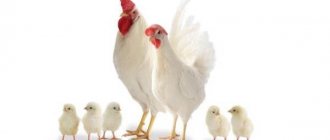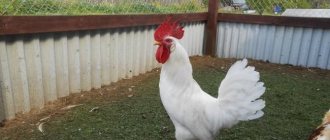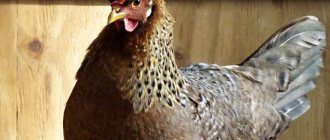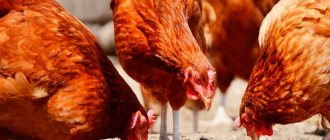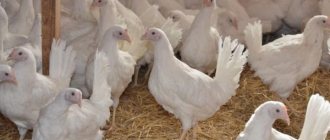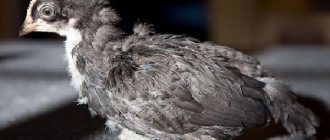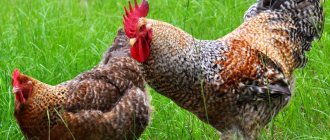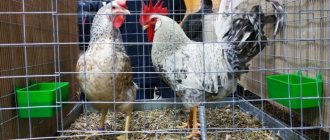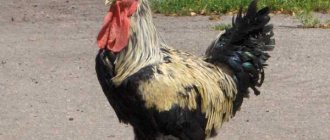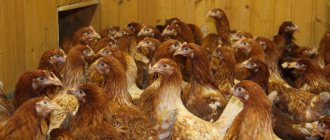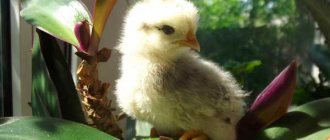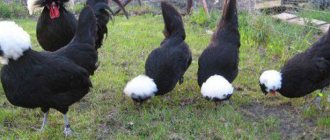Maintenance and care
A Siberian breed of chickens with such a degree of endurance and unpretentiousness is a rarity in our time.
Siberian women endure any hardships of life and living conditions. But, if you create good conditions and care for the black whales, they will reward you with good performance, good health and excellent appearance. Let's consider the most important points related to care and maintenance.
- Winged workers easily tolerate any climatic conditions, adapt to them and feel quite comfortable. Siberian frosts are not terrible for birds, and do not even harm their combs and earrings. The special structure of the V-shaped comb, covered with a fluffy cap, and earrings hidden in the beard, allow the birds to withstand any frost. Warm “pants” carefully cover the legs and toes so that the birds do not freeze. You can successfully keep moths both in central Russia and in regions with harsh climates.
- Arrangement of your home for the winter must begin with major insulation. It is recommended to build small perches - no more than 30 cm in height. The quonsets do not fly high, but a slight elevation will help them feel more comfortable during the winter months.
- Clean, dry and high-quality bedding is the key to the beauty of feather “coats”. High humidity, swamp, dirt - all this deprives the beauties of their decorative value.
- Another important nuance of caring for feathers is that ash-sand baths are necessary for quons every day.
Molting and break in egg production
The seasonal molting process can be long. As a rule, the winged flock tolerates this period easily, but there are cases when the birds weaken and become sensitive to diseases. If typical signs of the disease appear, it is recommended to isolate the weakened hen for quarantine.
If it turns out that everything is fine with her, you can return her to her family after 30-40 days. As a rule, birds molt in late autumn or winter. It is advisable to give them the opportunity to eat better during this period.
Planned herd replacement
To date, there are no recommendations regarding the timing of planned herd replacement. The fact is that the Siberian breed of chickens is at the recovery stage, and so far there are no absolute results. It is known that moths are famous for their longevity, but they can be maximally productive for up to 3 years.
Frequent illnesses
Fortunately, furry beauties do not get sick often. Survival rate among young animals and adults is about 97-99%. Colds are not terrible, but the biggest enemy of the winged family is parasites. Fleas, ticks and lice eaters pose a danger to individuals of all ages and both sexes.
Ticks are also carriers of serious infections that can wipe out an entire herd in a matter of days.
It is very important to vaccinate birds to reduce the risk of developing diseases, as well as carry out preventive treatments to avoid parasite attacks
Raising chickens
Reproduction of purebred chickens is not much different from ordinary ones: incubation, “work” of a hen, or buy ready-made chickens.
Incubation and brooding by laying hens
For incubation, eggs are collected for no more than 10 days, providing them with good ventilation and turning. Select medium-sized specimens of regular shape without spots. They cannot be washed. Otherwise, you should maintain the temperature and humidity in the incubator at the recommended levels and turn the eggs promptly for 21 days.
Calm and “correct” hens - Siberian moths and Ushankas. All the rest are very timid, require care and peace, and are fickle in their desire to breed. Hens that are heavy can crush eggs, which should be taken into account when breeding, for example, Cochins.
Shaggy-legged chickens are vulnerable and therefore require careful handling: warmth, cleanliness, proper lighting and ventilation, and dryness. This will require bedding made of sawdust or straw, infrared lamps to maintain the required temperature and sufficient light, etc. The daylight hours of day-old chicks last 24 hours and are shortened every day until reaching 8 hours in 14 days.
Feeding
The food must be balanced and contain the necessary minerals, vitamins and trace elements. It is given first at intervals of 2 hours, from days 10 to 45 - at 3 hours, and then fed 4 times a day.
The first food for babies is crushed egg, nettle, boiled millet, then cottage cheese, greens with mixed feed (from 14 days of age), broth, yogurt, as well as additives from coarse sand, chalk, meat and bone and fish meal, wood ash, yeast. Give clean water, fermented milk products with vitamins or antibiotics if necessary.
Weakened chicks can be seen by their empty crop, drowsiness, and low activity.
They are separated from healthy fidgets and nursed separately, giving them special attention
Incubation
An incubator is rarely used for breeding - hens breed their offspring on their own.
Table of temperature and humidity modes
| Period |
